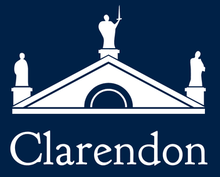Clarendon Fund

The Clarendon Fund is a global scholarship scheme at the University of Oxford.[1] Established in 2000 and launched in 2001,[2] annually, the scheme creates approximately 140 Clarendon Scholarships, formerly referred to as Clarendon Fund Bursaries, to university graduates from around the world and from across all subject areas, who demonstrate academic excellence and potential. In 2014, the scholarship community represents more than 50 nationalities.[1]
The Clarendon Scholarship enables the most distinguished and competitive scholars to undertake part- or full-time degree-bearing graduate study, including taught master's degrees (i.e., M.St., M.Sc., B.C.L., M.F.E., M.Phil., M.Th.), research master's (i.e., M.Sc. by Research), and research doctorates (i.e., D.Phil.s) at the University.[3] It fully covers tuition and college fees[4] and provides a generous grant for living expenses.[4]
As of 2014, there have been more than 1,300 recipients of scholarships from the Clarendon Fund, including around 350 Clarendon Scholars at Oxford in the academic year of 2014/15.[5]
History
Financed by the Oxford University Press, the Clarendon Fund was established by the Council of the University of Oxford in 2000 and launched in 2001.[2] The original aim of the Fund, as agreed by the Council, was to "assist the best overseas [graduate] students who obtain places to study in the University", regardless of financial capability and to remove any barriers between the best prospective graduate students and studying at the University of Oxford.[2] However, in the year of the Clarendon Fund's 10th anniversary, from 1 September 2011, the ambit of the Fund and its scholarships would be expanded to include all nationalities and all fee statuses, as opposed to not only candidates with overseas fee status.[1]
The Clarendon Fund is sponsored by Oxford University Press, from which it has received more than £37 million. Not only does it cover fees and living expenses, but the scholarship community is also very active, providing scholars with opportunities ranging from career-oriented to cultural and social events, to foster long-lasting friendships between the scholars.[2]
Selection
Every applicant for graduate studies at the University of Oxford is automatically considered for the Clarendon Scholarship. Unlike many scholarships that highlight the need for a track record of leadership among their applicants, the Clarendon Scholarship focuses primarily on proven academic performance and future potential for advancing their fields of study during and beyond their time in Oxford. Oxford believes that by electing and nurturing the best and brightest minds in any given field the advancement of their study at Oxford will, by its very nature, produce leaders in that field. The process of selection aims to award the scholarship to an equal number of students from each of the University's four academic divisions, allowing interdisciplinary interaction amongst the scholars. The scholarships are highly competitive, with approximately 2% of first-year graduate students being offered the scholarship.[6]
Scholars' Council
The Clarendon Scholars' Council provides a platform to facilitate professional, academic and social development opportunities through an intellectually and socially interactive community. The Council for the Clarendon Scholars' Association is composed of several elected council officers as well as permanent representatives from the University. As a collective group, the council works to promote the reputation and global awareness of the Clarendon Scholarship and Oxford University through a strong alumni network, and internal and external collaborations.[7] Former presidents of the association include: Claire Higgins (2012), Ramtin Amin (2013), Matthijs Vákár (2014), Robert Brand (2015) and Christine Moore (2016).[8]
Symbols
Name
Edward Hyde, later Earl of Clarendon and also Chancellor of the University of Oxford from 1660-1667, wrote a famous and highly profitable work, History of the Great Rebellion, about the English Civil War of the 17th century. The profits of his book were used to construct the University-owned Clarendon Building on Broad Street in central Oxford. The Clarendon Building was designed to house Oxford University Press (OUP), and so the Clarendon Fund was named in honour of this famous building and its historic linkages to OUP, the main benefactor of the Clarendon Scholarships.
Logo
The Clarendon Fund logo was designed in 2009 in the run-up to the Fund's 10th anniversary, and simplified and updated in 2014. It celebrates both the long history and traditions of Oxford and of OUP, as well as welcoming the Clarendon scholars who will write the pages of the University's future.
It shows the statues of the Muses at the top of the Clarendon building, which are perhaps the building's most recognisable feature and an iconic part of the Oxford skyline. The building was constructed in the classical style from 1711-13 on the design of Nicholas Hawksmoor, a pupil of the famous architect Sir Christopher Wren.
The font used with the logo is called Trajan Pro and has its origins in the Roman lettering found on Trajan's Column, which was completed in 113 CE. It was chosen specifically to complement the architectural style of the Clarendon building. Trajan remains one of the most widely used fonts in book jacket cover design, a further link to the Clarendon Building's original use as the home of OUP.
References
- 1 2 3 "About the Clarendon Fund". University of Oxford.
- 1 2 3 4 "History of the Clarendon Fund". University of Oxford.
- ↑ "Frequently Asked Questions -The Clarendon Scholarships". University of Oxford.
- 1 2 "Value and Duration of the Scholarship". University of Oxford.
- ↑ "Ten years, 1,000 Clarendon Scholars for Oxford". University of Oxford. 12 October 2011.
- ↑ "Clarendon | University of Oxford". www.clarendon.ox.ac.uk. Retrieved 2016-09-03.
- ↑ "Clarendon Scholars' Council | Clarendon Scholarships | University of Oxford". www.ox.ac.uk. Retrieved 2016-09-03.
- ↑ "Scholars' newsletter | Clarendon Scholarships | University of Oxford". www.ox.ac.uk. Retrieved 2016-09-03.